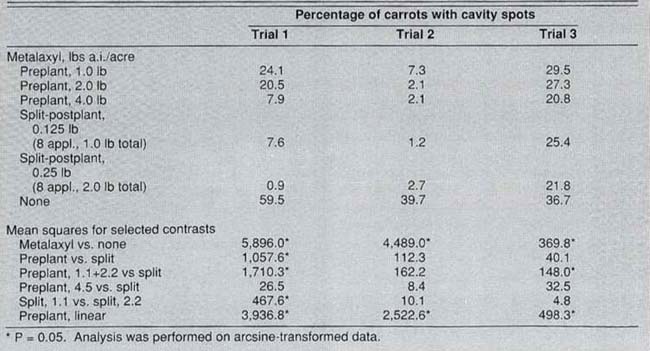All Issues
If registered, fungicide could reduce cavity spot of carrots
Publication Information
California Agriculture 45(2):29-30.
Published March 01, 1991
PDF | Citation | Permissions
Abstract
No control measures are now available for reducing losses to cavity spot, the most damaging carrot disease in California. Researchers have found a fungicide that provides excellent control of the disease, though it is not yet registered for use on carrots.
Full text
Cavity spot is a serious disease of carrots in California's San Joaquin Valley, where nearly 25,000 acres are planted annually. Occasionally, whole fields must be abandoned because of a high incidence of disease. No control measures are currently available.
Cavity spot lesions are elliptical, oriented across the breadth of the root, generally smaller than 1/2 inch in diameter, and no more than 1/8 inch deep. In 1961, cavity spot was reported to be a physiological disorder induced by a deficiency of calcium. Since then, it has also been attributed to anaerobic bacteria and to stress from flooding and high soil temperatures. Recent investigations in Europe showed that Pythium species, especially P. violae, were associated with cavity spot lesions. The purpose of our study was to determine the cause and control of cavity spot of carrots in the San Joaquin Valley.
To isolate potential pathogens, we collected tissue from the margin of cavity spot lesions on carrots in Kern County fields, placed samples aseptically on a medium selective for Pythium and related fungi (corn meal agar plus antibiotics) and on various standard media for the isolation of bacteria and other fungi. These isolations yielded P. violae and, less frequently, P. ultimum. No other organisms were recovered with any consistency. In controlled greenhouse tests, all the carrots grown in soil inoculated with P. violae and 65% of carrots grown in soil inoculated with P. ultimum developed typical cavity spot lesions. Both fungi were subsequently recovered from lesions plated on corn meal agar.
Several experiments were designed to test the preplant and postplant efficacy of metalaxyl (Ridomil) on the control of cavity spot in several commercial fields of carrots in Kern County. In one experiment, metalaxyl (2E and 5G formulations) was applied as a single preplant application (1, 2, or 4 lb active ingredient [ai]/acre) or as eight applications (0.125 or 0.25 lb ai/acre [2E formulation only]) made about every 2 weeks throughout the season, for a total of 1 or 2 lb ai/acre. The 5G formulation was spread in the planting furrow, and the 2E formulation was sprayed on the surface of the soil or over, the carrots before an irrigation. Six 30-foot-long replications were arranged in a randomized complete block design.
All the carrots in 3 feet of row from each plot (about 115 carrots for each 3-foot sample) were harvested at maturity, washed, weighed, and examined for cavity spots. Results were expressed as the percentage of carrots with cavity spot lesions. The experiment was conducted in two commercial fields in 1987 and in one in 1988. All fields were sprinkler-irrigated.
In another experiment, single applications of 2 lb ai of metalaxyl per acre were applied either 43 or 53 days after planting in one field, and 49 or 59 days after planting in another field. Single applications of metalaxyl at 1 lb ai/ acre were also applied 15, 30, 45, 60, or 75 days after planting in an additional trial. Treatments were replicated as previously described.
Metalaxyl significantly reduced the incidence of cavity spot in all trials (table 1). In two trials, metalaxyl almost completely eliminated the disease. In two of the three trials, the control achieved with a seasonal total of 1 or 2 lb ai of metalaxyl per acre in split applications was significantly greater than was achieved with the single preplant application of 1 or 2 lb. However, there was no significant difference between the efficacy of the split applications and the efficacy of a single preplant application of metalaxyl at 4 lb ai/acre. There was a significant negative correlation between the rate of metalaxyl applied preplant and the percentage of carrots with cavity spot lesions. There were no significant differences in disease control with the different metalaxyl formulations (5G and 2E). Carrot yields were not influenced by metalaxyl applications or cavity spot incidence.
Single applications of metalaxyl at 2 lb ai/acre applied 40+ or 50+ days after planting also significantly reduced the incidence of cavity spot (table 2). We have other data indicating that single applications of metalaxyl at 1 lb ai/acre applied at different times during the season failed to reduce the incidence of cavity spot.
Conclusions
Pathogenicity tests and field trials with metalaxyl, which is active only on Pythium and related fungi, demonstrated the cavity spot on carrots in California is caused by Pythium species. Both P. violae and P. ultimum caused cavity spot lesions in controlled conditions, but P. violae was the more virulent fungus on carrots.
Metalaxyl is not currently registered in California for use on carrots, but it shows promise as an effective tool for reducing losses to cavity spot. In our study, soil drenches of metalaxyl applied 40 to 60 days after planting or multiple, dilute applications throughout the season were more efficacious than single preplant applications at comparable rates.







